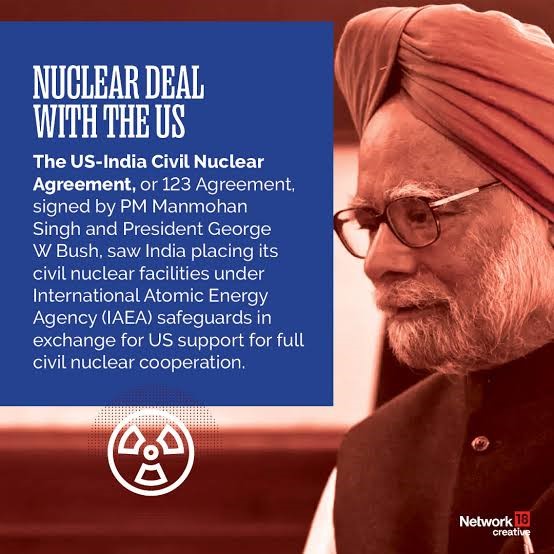Unlocking U.S.-India Nuclear Deal’s Full Potential
Syllabus:
GS 2:
- India and neighbourhood relations .
- Development of India’s relation with the west.
Why in the News?
The U.S.-India civil nuclear deal, signed in 2008, remains underutilized despite its transformative potential. Recent U.S. announcements on removing nuclear entities from the Entity List have rekindled hopes for progress.
The U.S.-India civil nuclear deal:
The U.S.-India civil nuclear deal, also known as the 123 Agreement, was signed in 2005. It was a landmark deal that ended a 30-year ban on nuclear trade between the two countries.
What was the agreement about?
- The agreement allowed India to access civilian nuclear technology and equipment.
- It enabled US businesses to sell nuclear fuel, reactors, and technology to India.
- India agreed to separate its civilian and military nuclear activities.
- India agreed to adhere to international nuclear and missile export guidelines.
- India agreed to continue its voluntary moratorium on nuclear testing.
What was the significance of the agreement?
- The agreement ended India’s nuclear isolation.
- It helped India meet its energy security and environmental sustainability needs.
- It strengthened the strategic partnership between the U.S. and India.
- It addressed India’s energy needs.
Transformative Potential of the U.S.-India Nuclear Deal
- Strategic trust: The nuclear deal marked a historic shift, fostering deeper defence cooperation, advanced technology transfers, intelligence sharing, and joint military exercises between India and the U.S.
- Clean energy goals: It promised to transform India’s energy landscape by enabling clean nuclear energy production, reducing reliance on fossil fuels, and supporting sustainable economic growth.
- Economic impact: The deal envisaged generating substantial employment opportunities, promoting industrial growth, and ensuring India’s energy security by boosting nuclear infrastructure and creating high-tech jobs in both nations.
- Geopolitical implications: Strengthening ties with the U.S. through nuclear collaboration has bolstered India’s global standing and enhanced its role as a critical player in regional geopolitics.
Key Challenges Hindering Progress
- Liability roadblocks: India’s Civil Liability for Nuclear Damage Act imposes heavy financial risks on suppliers, discouraging U.S. companies like GE and Westinghouse from participating in nuclear projects.
- High costs: The advanced nuclear technology offered by U.S. firms is expensive, raising concerns about affordability and potential cost overruns, deterring large-scale adoption.
- Regulatory barriers: U.S. export controls on dual-use technologies, along with lingering trust issues, have created hurdles for seamless cooperation in sensitive nuclear technology transfers.
- Geopolitical competition: Russia’s dominance in India’s nuclear sector, supported by sovereign guarantees and favorable policies, limits opportunities for U.S. companies to establish a foothold.
- Insurance limitations: India’s liability insurance framework, though improved, does not fully address the risks perceived by U.S. suppliers, hampering their confidence in project participation.
Opportunities to Revive the Deal
- Technology cooperation: Leveraging U.S. advancements in nuclear technology can help India meet its clean energy goals while creating a collaborative platform for innovation and research.
- Policy adjustments: Harmonizing liability provisions with global norms and easing export restrictions can build trust and ensure smoother collaboration between India and the U.S.
- Government support: Increased bilateral cooperation through government-led risk-sharing frameworks can address financial concerns and encourage private sector involvement in nuclear projects.
- Leveraging geopolitical shifts: Amid changing global dynamics, stronger nuclear ties can position India and the U.S. as strategic allies, promoting peace and stability in the Indo-Pacific region.
Way Forward
- Streamlining liability frameworks: India and the U.S. must collaboratively address supplier liability issues to create an enabling environment for private sector participation in nuclear projects.
- Focus on affordability: Ensuring cost-effective solutions tailored to India’s energy needs can make U.S. nuclear technology more accessible and appealing for large-scale implementation.
- Public-private collaboration: Facilitating partnerships between U.S. firms and Indian agencies can resolve technical and financial bottlenecks, accelerating progress in nuclear infrastructure development.
- Climate leadership: Revitalizing the nuclear deal can position both nations as global leaders in combating climate change through sustainable and clean energy initiatives.
Conclusion
The U.S.-India nuclear deal holds immense potential for addressing energy security, advancing clean energy solutions, and fostering strategic trust. By resolving liability risks, affordability issues, and regulatory barriers, both nations can unlock its true promise. This will not only strengthen bilateral ties but also contribute to regional stability and global energy sustainability.
Source: Indian Express
Mains Practice Question
Examine the potential of the U.S.-India nuclear deal in fostering clean energy collaboration. Discuss the challenges it faces and propose solutions to maximize its benefits.




